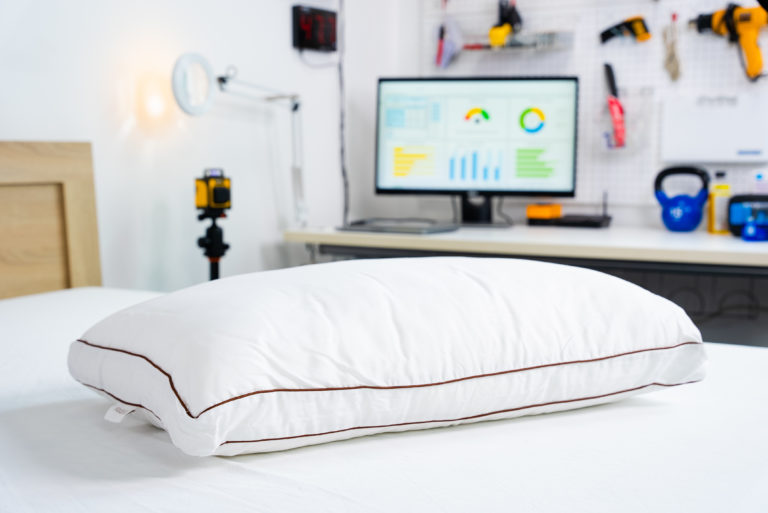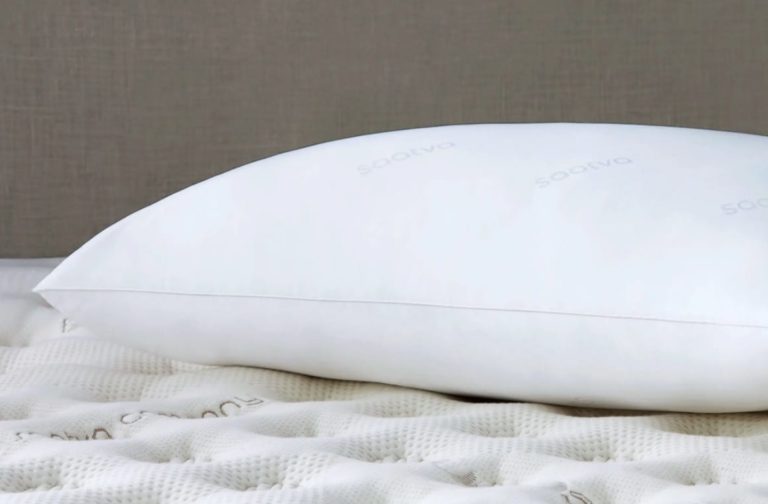When you buy through our links, we may earn a commission. Products or services may be offered by an affiliated entity. Learn more.
Sleepers who experience back pain may be wondering what role their pillow plays each night. The right pillow can help reduce pressure and tension in the neck and shoulders and keep the spine aligned. It can also provide comfort and help improve sleep quality.
A pillow can be used under the head to alleviate back pain symptoms, but it can also be placed underneath the legs or lumbar region to relieve pressure and promote spinal alignment.
Choosing the best pillow for back pain may feel overwhelming at first, especially with the sheer number of options available to shoppers. We’ll break down our top picks, explaining the construction and materials that help alleviate back pain. We’ll also take a closer look at the relationship between back pain and sleep, and how people with back pain can find relief.
Our Top Picks
-
Best Overall – Saatva Latex Pillow
View Details
-
Best Value – Brooklyn Bedding Talalay Latex Pillow
View Details
-
Most Comfortable – Sweet Zzz Plant-Based Pillow
View Details
-
Best for Spinal Alignment – Silk & Snow Pillow
View Details
-
Best Adjustable – Luxome LAYR Customizable Pillow
View Details
-
Best Wedge Pillow – Helix Wedge Pillow
View Details
-
Best for Combination Sleepers – Layla Kapok Pillow
View Details
Swipe for more
Best Overall
Saatva Latex Pillow
9.6 /10
Test Lab Score
Use this link for the most current discount.
Use this link for the most current discount.
The Saatva Latex Pillow combines plush comfort with sturdy support thanks to its dual-layer design featuring a responsive Talalay latex core and a soft down alternative fill. Ideal for sleepers with back pain, it offers adjustable loft, excellent pressure relief, and standout temperature regulation.

Price Range
$165 – $185
Fill
Shredded Talalay latex and down alternative
Firmness
Medium Soft
Full Details
Shoppers who want a pillow that’s both supportive and responsive will likely find the Saatva Latex Pillow a good fit. Saatva’s model features two fill materials, which combine to give sleepers a pillow that’s both plush and stable. Though it has a sticker price that’s on the high side of average, some shoppers made find this pillow’s high-quality construction and materials are worth the cost.
Those who want pressure relief without sacrificing support may find a latex pillow suitable. The Saatva’s core is made from shredded Talalay latex engineered to alleviate pressure points and provide a stable base for your neck and head. Down alternative fill wraps the core and provides a soft, plush surface. Sleepers who want to adjust the pillow’s loft can remove the down alternative layer.
Talalay latex is also well-known for its temperature regulation, which the 100% cotton cover enhances. Latex is durable and typically has a long lifespan. To ensure its longevity, sleepers should not wash the pillow’s latex core. Saatva recommends washing the down alternative layer and cover in your home washing machine.
Saatva ships the Latex Pillow for free to shoppers living in the contiguous U.S., and backs it with a 1-year warranty. A 45-day sleep trial is also included with your purchase. Refunds are not issued outside this window.
Best Value
Brooklyn Bedding Talalay Latex Pillow
9.0 /10
Test Lab Score
25% off sitewide
25% off sitewide
The Brooklyn Bedding Talalay Latex Pillow offers durable, breathable support at an affordable price. With two loft options, a responsive latex core, and a cooling Tencel cover, this pillow balances comfort and alignment without breaking the bank.
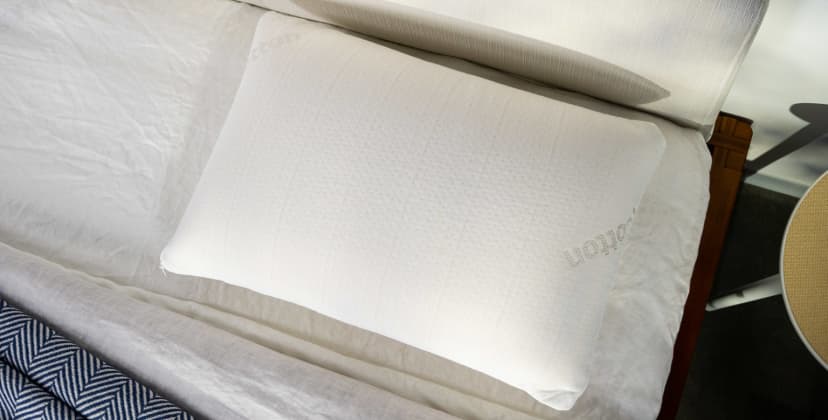
Price Range
$89 – $99
Fill
Talalay latex
Firmness
Medium Firm
Full Details
Investing in a pillow that alleviates back pain doesn’t need to empty your wallet, even if you opt for a model made from high-quality materials. The Brooklyn Bedding Talalay Latex Pillow is breathable, supportive, and long-lasting, so it nicely measures up to competitors, but the sticker price falls well below average compared to other pillows with latex fill.
Solid Talalay latex creates a responsive core for the pillow, resulting in a light bounce when you lie down and gentle cushioning for your head and neck. The latex is ventilated with small holes to promote airflow and help the pillow maintain a comfortable temperature. Another cooling component is the cover, which is made of moisture-wicking Tencel fabric derived from eucalyptus trees.
You can choose from two loft levels. Our hands-on tests show the 4-inch design is best suited for back sleepers, as well as combination sleepers who largely favor the back position. This mid-level profile delivers optimal support without straining the neck. If you primarily sleep on your side, the 5-inch profile should provide adequate cushioning to fill the space between your head and downward-facing shoulder.
You may remove and machine-wash the cover as needed, but the latex should only be spot cleaned — exposure to moisture can warp the material and cause permanent damage. Queen and king sizes are available. In addition to its approachable price tag, the Talalay Latex Pillow qualifies for free ground shipping throughout the contiguous U.S. Your sleep trial runs for 30 nights, and your purchase is further backed by a three-year warranty against manufacturing defects.
Most Comfortable
Sweet Zzz Plant-Based Pillow
8.4 /10
Test Lab Score
Use code SF10 for 10% off sitewide
Use code SF10 for 10% off sitewide
The Sweet Zzz Plant-Based Pillow is a soft, eco-friendly alternative to down that offers gentle support and mid-range loft. Made with breathable natural cotton and washable plant-based fill, it’s a great pick for allergy-sensitive shoppers or anyone avoiding animal products.
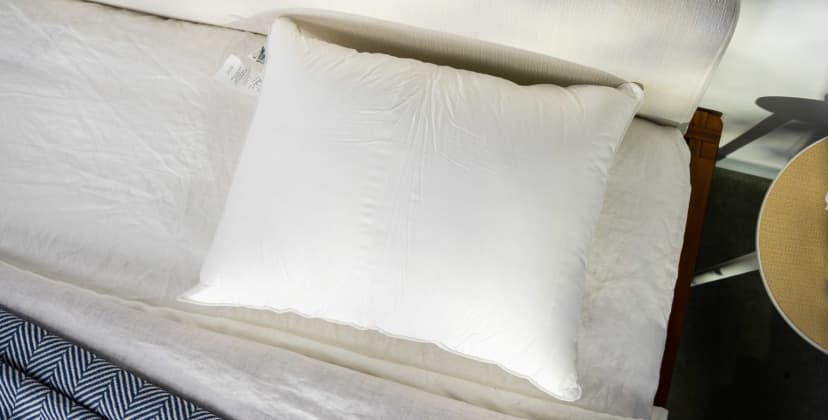
Price Range
$135 – $150
Fill
Plant-based down alternative fibers
Firmness
Medium
Full Details
Most down alternative pillows contain fill made of polyester or viscose from bamboo. The Sweet Zzz Plant-Based Pillow’s fill is composed of plush clusters derived from plant matter. This material mimics the lightness and softness of real down without relying on synthetic fabrics. It is also safe for people with down allergies, and a good choice for people who would rather not buy products that use animal-based materials. Back sleepers are also good candidates for this pillow, as seen during our product tests. Mid-range loft and decent support allow back sleepers to lie comfortably without too much sinkage around the head, neck, or shoulders.
The shell is made of smooth natural cotton. This fabric is highly breathable and the fill retains very little heat, so the pillow should sleep reasonably cool in most climates. You can wash and dry the entire pillow in your household appliances. Machine wash with similar colors on a gentle cycle, then tumble dry on low heat. Avoid ironing or dry cleaning the pillow, as both can cause permanent damage. Standard and king sizes are available.
The Plant-Based Pillow is affordably priced in each size and shipping is free of charge for all customers in the contiguous U.S. Sweet Zzz also offers accessible shipping rates for orders to Alaska, Hawaii, and Canada. Each purchase is backed by a 50-night trial, during which you can return your undamaged pillow for a full refund or exchange it. You’ll also receive a manufacturer’s warranty that covers structural and material defects for up to 1 year.
Best for Side Sleepers
Eli & Elm Cotton Side-Sleeper Pillow
8.9 /10
Test Lab Score
20% off
20% off
The Eli & Elm Cotton Side-Sleeper Pillow features a unique curved shape that promotes healthy spinal alignment for side sleepers, helping reduce pressure on the neck, shoulders, and back. With adjustable loft and a plush latex-down alternative fill, it offers customizable comfort in a breathable, machine-washable design.
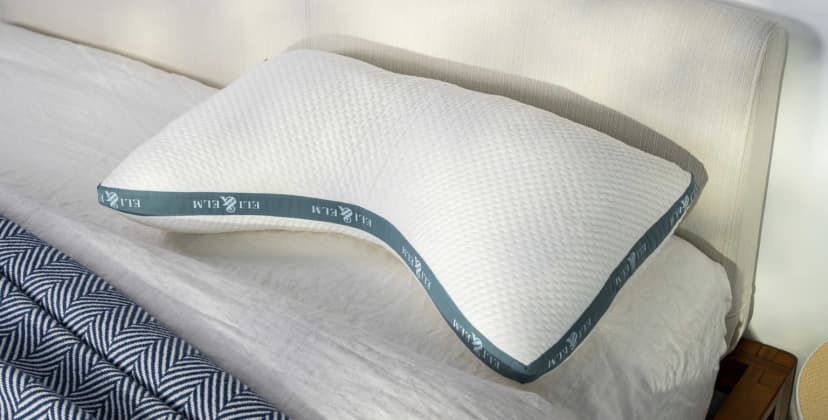
Price Range
$115 – $124
Fill
75% shredded latex or shredded memory foam, 25% polyester fiber
Firmness
Medium, Adjustable
Full Details
The ergonomic Eli & Elm Cotton Side-Sleeper Pillow is designed with an oblong shape. This allows you to rest comfortably on your side with your neck slightly elevated and your shoulders aligned with the spine, which can alleviate pain and pressure points in these areas as well as the back and hips. The pillow contains a shredded blend of latex and down alternative fibers, creating a plush yet supportive feel.
The pillow is also adjustable, as you can add or remove fill to change the loft and density. This makes the pillow suitable for any side sleeper regardless of their thickness preferences. The cover is made from a soft and breathable blend of cotton, polyester, and spandex.
One size is available for the pillow. When it needs to be cleaned, simply remove the fill and wash and dry the cover in your household machines. Eli & Elm allows customers to bundle their purchase and save money on additional products, such as sheets, mattress protectors, and other pillows.
Eli & Elm provides free ground delivery to all customers within the contiguous U.S. You may return your pillow within 45 days of the original purchase, even if you’ve slept on it or washed the cover, and you’ll also receive a five-year warranty.
Best for Spinal Alignment
Silk & Snow Pillow
9.0 /10
Test Lab Score
Use this link for the most current discount.
Use this link for the most current discount.
The Silk & Snow Pillow combines adjustable shredded memory foam and plush down alternative fill to provide a balance of support and softness that’s ideal for back and stomach sleepers. It features a breathable cotton cover, machine-washable design, and accessible price-point.
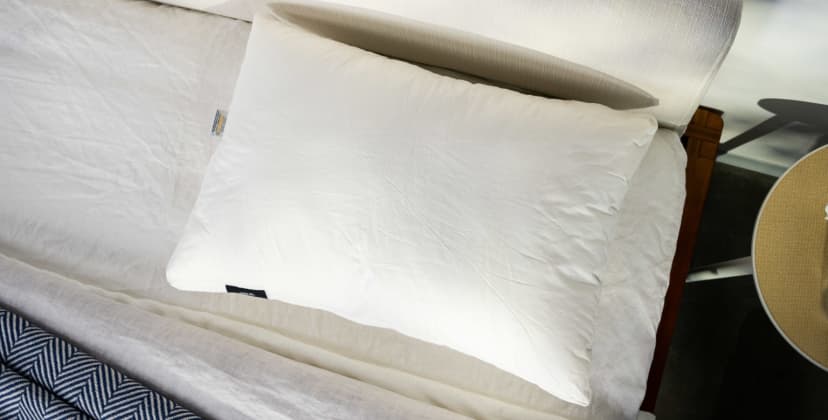
Price Range
$75 – $85
Fill
Shredded memory foam and down alternative fibers
Firmness
Medium
Full Details
People who experience back pain can sometimes find relief through a combination of pressure relief and robust support. The Silk & Snow Pillow’s core is made from shredded memory foam that alleviates pressure by gently cradling your head and neck. The adjustable fill ensures that any sleeper can create a comfortable loft level. This model also comes in at a below-average price-point that may be attractive to value seekers.
Surrounding the shredded memory foam core is another chamber filled with down alternative microfiber. This layer adds a bit of plushness and keeps the pillow feeling airy. Together, the foam and fiber give the pillow a medium feel that’s suitable for back and stomach sleepers, though side sleepers can opt to keep all the fill in place to get the highest loft level.
You can remove the breathable cotton cover easily and wash it in your home machine. Silk & Snow offers a lengthy 100-night sleep trial that requires you first use your pillow for 30 days before starting a return. It’s backed by a 3-year warranty that covers material and workmanship defects. Shoppers in the contiguous U.S. and Canada can expect free shipping, while those in Hawaii and Canadian territories will have an additional charge.
Best Adjustable
Luxome LAYR Customizable Pillow
9.1 /10
Test Lab Score
Use this link for the most current discount.
Use this link for the most current discount.
The Luxome LAYR Pillow offers a fully customizable sleep experience with interchangeable inserts made of shredded foam, solid foam, and down alternative fill—allowing sleepers to fine-tune loft and firmness based on their preferred sleep position.
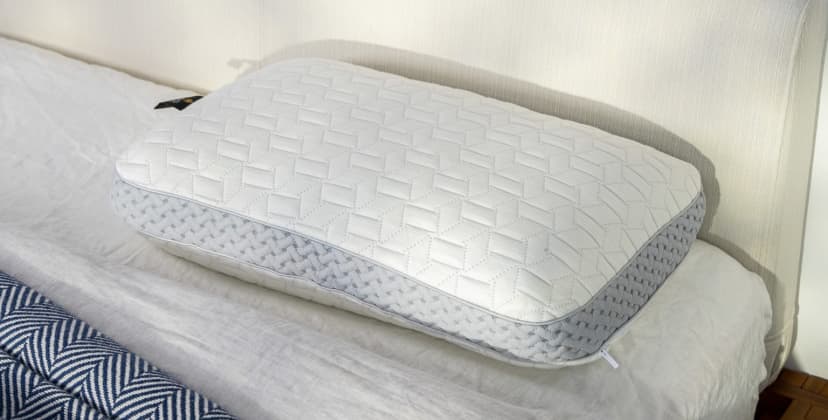
Price Range
$140 – $160
Fill
Down alternative, shredded gel-infused memory foam, and solid gel-infused memory foam
Firmness
Adjustable
Full Details
Proper neck support and alignment is crucial to alleviating back pain. The Luxome LAYR’s fully customizable design ensures a comfortable surface for your head and neck no matter which sleep position — or positions — you normally use. Each pillow comes with inserts containing down alternative fibers, shredded memory foam, and solid foam. You can add, remove, and rearrange these inserts until you’ve achieved the ideal loft and firmness based on your sleep style.
The pillow comes fully assembled, so you may need a night or two to pinpoint the most comfortable configuration. Side sleepers on our testing team preferred to use three or four inserts, beginning with the shredded foam or down alternative on top and solid foam forming the base — this creates plenty of loft to fill the space between your head and downward-facing shoulder when you lie in the side position. Back sleepers don’t need as much loft, so they should feel comfortable with two to three inserts max. If you’re a stomach sleeper, chances are you won’t need more than two inserts.
Each insert is encased in a cotton liner, and the pillow’s outer cover is made of breathable, moisture-wicking viscose derived from bamboo. Side vents on the cover promote steady airflow for added breathability. You may separate and machine-wash the inserts and cover in any household machine, but the fill should never be laundered — this can cause permanent damage. Standard and king sizes are available.
The LAYR is competitively priced and standard shipping is free for all orders in the contiguous U.S. If you purchase two pillows, Luxome also offers a generous 50% discount on the second. Your order includes a sleep trial that runs for 30 nights, during which you may return the pillow for a refund if you aren’t satisfied.
Best Wedge Pillow
Helix Wedge Pillow
8.6 /10
Test Lab Score
Use this link for the most current Helix discounts
Use this link for the most current Helix discounts
The Helix Wedge Pillow combines medium firm support with a 10-inch incline to promote healthy spinal alignment. Its gel-infused memory foam contours gently while maintaining lift, and the versatile design also benefits people who snore, have acid reflux, or want to elevate their legs to ease pressure on the lower back.
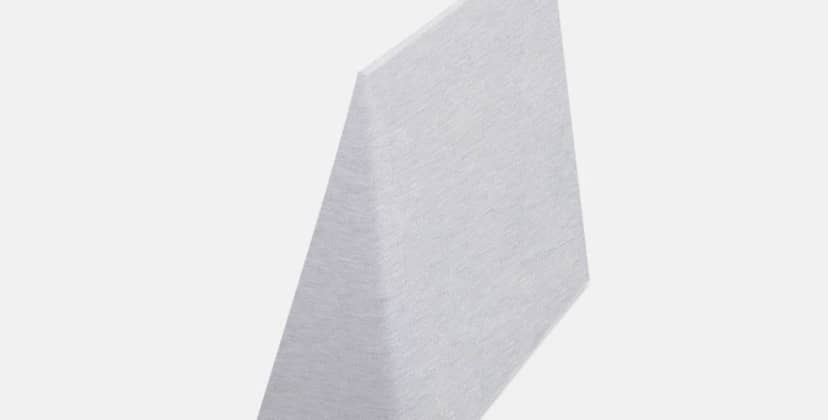
Price
$109
Fill
Gel Memory Foam and Polyfoam
Firmness
Medium Firm
Full Details
The Helix Wedge Pillow is a versatile model with a medium firm feel that’s equally comfortable for sleeping and relaxing. It’s made from gel-infused memory foam and polyfoam that conform to your shape while still keeping your head and body supported. The balanced feel and wedge design promote spinal alignment and reduce back pain.
The tallest part of the wedge measures 10 inches thick, which is a height that’s well-suited to back and side sleepers. Stomach sleepers may find the incline causes their necks to bend uncomfortably. However, you don’t have to use this model under your head – you can also use it to prop yourself up while reading in bed, or place it beneath your knees to take pressure off your lower back.
People who snore and those who experience acid reflux often turn to wedge pillows to keep their heads slightly elevated while sleeping. This posture can help prevent snoring by keeping your airway clear. Some sleepers also find it beneficial for preventing heartburn.
This model includes a removable polyester and rayon blend cover that’s machine-washable. Your purchase includes a 100-night sleep trial and a one-year warranty. Shoppers in all 50 states enjoy free shipping.
Best Therapeutic Body Pillow
MedCline Therapeutic Body Pillow
7.4 /10
Test Lab Score
Use this link for the most current MedCline discounts
Use this link for the most current MedCline discounts
The MedCline Therapeutic Body Pillow features a J-shaped ergonomic design that’s especially helpful for side sleepers seeking back and hip pain relief. Its shredded memory foam fill offers sturdy, pressure-relieving support, and the adjustable shape allows for personalized comfort.
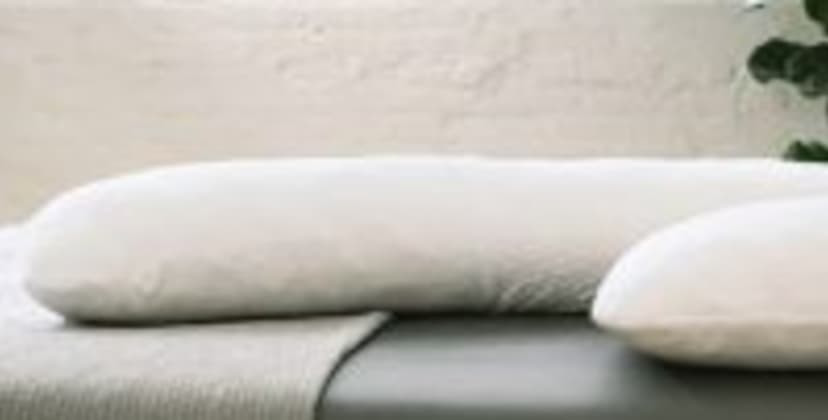
Price
$120
Fill
Shredded memory foam
Firmness
Medium
Full Details
Many people with persistent back pain find relief with a body pillow. MedCline’s Therapeutic Body Pillow stands out from the competition thanks to its ergonomic J-shaped design, which is ideal for side sleepers — tucking the pillow between your knees can promote even alignment, support the lumbar region, and reduce lower back and hip pain for people who use this position. Shredded memory foam fill also creates a denser and cushier feel compared to other body pillows sold today, most of which are stuffed with down alternative fibers.
You can squeeze the pillow to distribute more fill to certain sections. This helps ensure extra cushioning for areas of your body where pressure tends to build. Two sizes are available based on height. The small is recommended for people who stand 5 feet 1 inch or shorter, while the medium/large should accommodate anyone 5 feet 2 inches or taller. All pillows come with cases that can be removed and laundered in your household appliances. The insert should never be machine-washed.
The Therapeutic Body Pillow is somewhat expensive, but MedCline covers shipping costs for most customers in the contiguous U.S. Returns are not allowed after the pillow has been removed from its packaging, but your purchase is backed by a one-year warranty against manufacturing defects.
Best for Combination Sleepers
Layla Kapok Pillow
9.3 /10
Test Lab Score
Use this link for the most current discount.
Use this link for the most current discount.
The Layla Kapok Pillow blends shredded memory foam with natural kapok fibers to provide supportive, pressure-relieving comfort that helps reduce back pain. It features a moldable, adjustable loft and a breathable, copper-infused cover for cooling and antimicrobial benefits.
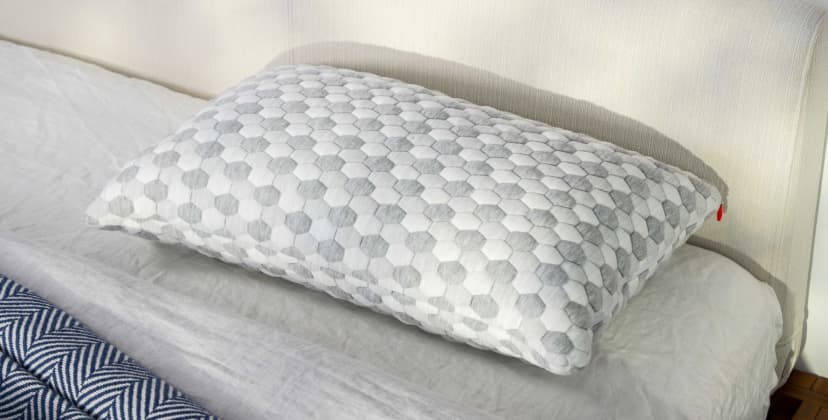
Price Range
$109 – $129
Fill
Shredded memory foam and kapok tree fiber blend
Firmness
Medium Soft
Full Details
The unique blend of shredded memory foam and natural kapok fibers in the Layla Kapok Pillow relieves pressure and promotes spinal alignment. This helps ease chronic back pain and ensures ample support for sleepers, including those who toss and turn at night. The Kapok Pillow is soft enough to be used underneath or between the knees to reduce pressure on the lower back.
The breathable cover of the Layla Kapok Pillow is woven with copper fibers, which help draw heat away from the body. In addition to temperature regulation, copper is antibacterial and odor-resistant. It has also been shown to help improve circulation.
The fill of the pillow includes natural kapok fibers, harvested from the seeds of the kapok tree. The fibers have a lightweight feel that is similar to down. The fibers maintain their loft and encourage airflow throughout the pillow. In addition to kapok fibers, the Layla Kapok Pillow includes shredded memory foam. The open-cell structure of the memory foam helps dissipate heat and moisture.
The plush feel of the Kapok Pillow conforms closely and cradles the head and neck. The pillow is responsive and can be molded into the sleeper’s preferred shape. The loft of the pillow is adjustable. The pillow arrives slightly overstuffed, and fill can be removed as needed.
The Layla Kapok Pillow is highly rated for durability and includes a 5-year warranty that covers defects in materials and workmanship. Spot cleaning the pillow is recommended, as machine washing it can void the warranty.
Shoppers can choose between a queen or king size. The Layla Kapok Pillow comes with a 100-night sleep trial. Layla asks that purchasers try out the pillow for two weeks before initiating a return.
Best Overall
Saatva Latex Pillow
9.6 /10
Test Lab Score
Use this link for the most current discount.
Shop at SaatvaA responsive latex pillow with a plush down alternative layer that balances pressure relief, support, and temperature regulation.
See More Details

Best Value
Brooklyn Bedding Talalay Latex Pillow
9.0 /10
Test Lab Score
25% off sitewide
Shop at Brooklyn BeddingA breathable and supportive Talalay latex pillow offered in two loft options, designed to keep you cool and comfortable at a wallet-friendly price.
See More Details
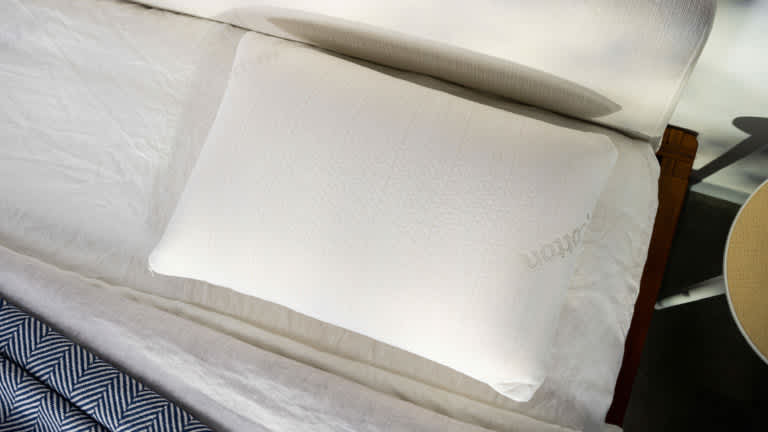
Most Comfortable
Sweet Zzz Plant-Based Pillow
8.4 /10
Test Lab Score
Use code SF10 for 10% off sitewide
Shop at Sweet ZzzA soft, plant-based down alternative pillow that stays cool, supports back sleepers, and offers an eco-friendly, hypoallergenic option at an affordable price.
See More Details
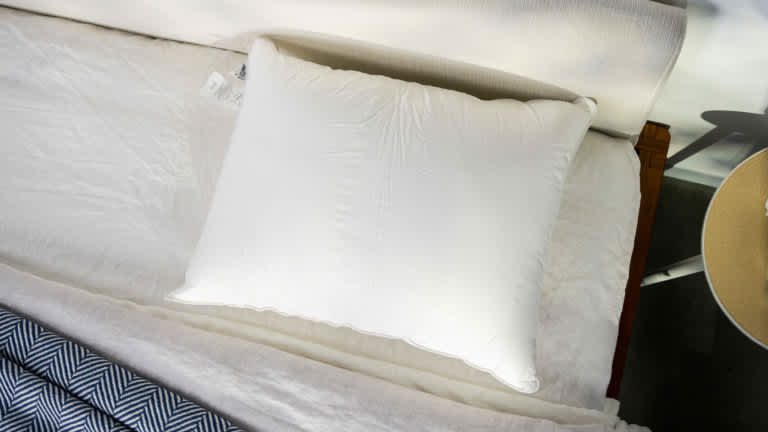
Best for Side Sleepers
Eli & Elm Cotton Side-Sleeper Pillow
8.9 /10
Test Lab Score
20% off
Shop at Eli & ElmA uniquely contoured pillow made for side sleepers, featuring adjustable fill and an ergonomic shape that promotes spinal alignment and eases pressure on the neck, back, and hips.
See More Details

Best for Spinal Alignment
Silk & Snow Pillow
9.0 /10
Test Lab Score
Use this link for the most current discount.
Shop at Silk & SnowAn adjustable shredded memory foam pillow with a plush microfiber layer, offering balanced support and pressure relief for back, stomach, and some side sleepers.
See More Details
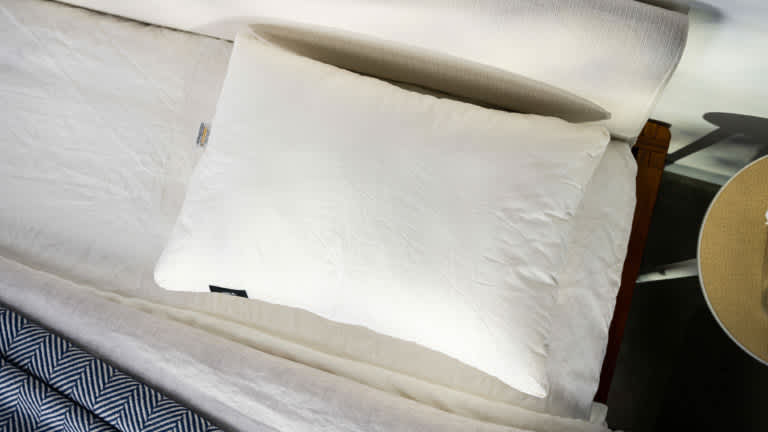
Best Adjustable
Luxome LAYR Customizable Pillow
9.1 /10
Test Lab Score
Use this link for the most current discount.
Shop at LuxomeA fully customizable pillow with interchangeable inserts — including down alternative, shredded foam, and solid foam — designed to offer tailored support for any sleep position.
See More Details

Best Wedge Pillow
Helix Wedge Pillow
8.6 /10
Test Lab Score
Use this link for the most current Helix discounts
Shop at HelixA medium firm wedge pillow made from gel-infused memory foam and polyfoam, designed to elevate the upper or lower body for better spinal alignment, snoring relief, and reduced back pain.
See More Details

Best Therapeutic Body Pillow
MedCline Therapeutic Body Pillow
7.4 /10
Test Lab Score
Use this link for the most current MedCline discounts
Shop at Sleep DoctorA dense, J-shaped body pillow filled with shredded memory foam that supports spinal alignment and relieves lower back and hip pain, especially for side sleepers.
See More Details
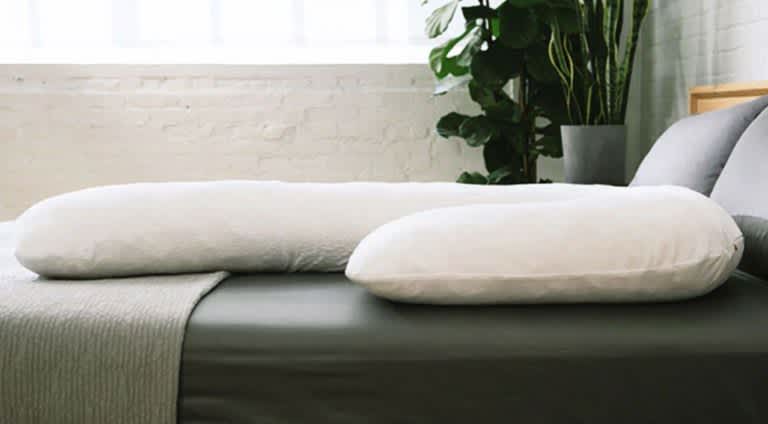
Best for Combination Sleepers
Layla Kapok Pillow
9.3 /10
Test Lab Score
Use this link for the most current discount.
Shop at LaylaA pressure-relieving pillow with a blend of natural kapok fibers and shredded memory foam that supports spinal alignment, regulates temperature, and offers adjustable loft for personalized comfort.
See More Details

How We Test: Rigor, Data, and Sleeper Feedback
Our team has years of experience testing pillows and other types bedding, and we choose our top product picks based on extensive in-house testing. To evaluate buckwheat pillows, we assess their comfort and breathability. We also examine other qualities like additional materials and adjustability. Our process consists of four primary stages.
Construction analysis: We begin by closely examining the pillow and making note of its material composition. This helps us determine durability and overall quality.
Product testing: In our Seattle Test Lab, team members take turns using the pillow. By doing so, we can see how comfortable and supportive the pillow is. We can also evaluate breathability, moisture control, and overall temperature regulation.
Field testing: Once our in-house tests have concluded, team members take the pillow home and test them in their own bedrooms for two to three weeks. Their daily notes help us understand how the pillow performs in real-world sleep environments.
User testing: We collect data from customer surveys and product reviews to see if our initial ratings align with opinions from the general public, or if they’re off the mark.
How Common Is Back Pain?
Back pain is quite common, as an estimated 80 percent of the population experiences symptoms at some point in their lives. Back pain can range in severity and frequency and it often affects the working population. Workers with back pain may miss days of work, or have limited mobility when they are on the job.
There are multiple factors that can cause back pain, and consulting with a doctor is an important step in determining a treatment plan and finding relief. Injuries can often lead to back pain. This includes injuries from exercising, playing sports, and lifting heavy objects. These activities may strain the muscles and ligaments in the back.
In addition to accidents and injuries, back pain can be caused by a ruptured, damaged, or herniated disk. Disks are part of the spine that sit between and cushion each vertebrae. Damage to a disk can also lead to nerve pain and muscle weakness.
Underlying issues including arthritis, osteoporosis, and fibromyalgia can contribute to back pain. Back pain is common during pregnancy, as the additional weight puts pressure on the lower back. Back pain can also be exacerbated by poor posture.
Types of Back Pain
There are several types of back pain, and understanding the severity and location of the pain can help when it comes to finding relief.
It is important to work with a medical professional to determine the underlying cause of back pain. Being able to describe the type of back pain you are experiencing is important. Back pain can be considered acute or chronic:
- Acute: Acute back pain typically has a sudden onset, and is often caused by an injury. This type of back pain heals as the underlying cause is resolved. This may involve a torn muscle or ligament, or damage to the tissue. Tissue damage generally takes three months to heal, so acute back pain often lasts three months or less. That said, acute back pain can turn into chronic back pain if the body does not properly heal.
- Chronic: Chronic back pain lasts longer than three to six months. It persists even after an injury heals. In these circumstances, the nervous system continues sending pain signals to the brain. Chronic back pain can also be the result of an underlying condition. Arthritis, osteoporosis, and fibromyalgia can all cause chronic back pain.
Whether back pain is chronic or acute, it can manifest in different areas of the back. The location of back pain can often point to the underlying cause.
- Low Back Pain: Low back pain is the most common type of back pain. It manifests in the lumbar region, specifically vertebrae L1 through L5. These five vertebrae, and the disks, ligaments, tendons, and muscles connected to them, help support the upper body. As a result, this area is at risk of injury when exercising or lifting heavy objects improperly. Weight gain and pregnancy can also strain the lower back. Using a pillow under the lumbar region can reduce pressure on the spine and help alleviate lower back pain.
- Mid-Back Pain: Mid-back pain occurs between the lumbar region and the bottom of the rib cage. This type of back pain is less likely to be caused by heavy lifting. Mid-back pain can be connected to more serious health issues like tumors or underlying conditions. Posture can play a role in worsening or preventing mid-back pain.
- Upper Back Pain: Upper back pain occurs in the thoracic spine, or the 12 vertebrae between the rib cage and neck. This type of back pain includes the shoulders, and is often affected by posture. Trauma or injury can also cause upper back pain. Serious conditions, including osteoporosis, arthritis, tumors, and narrowing of the spine can all lead to upper back pain. Like other types of back pain, upper back pain can also be a result of damage to the vertebrae, disks, muscles, or ligaments. Pillow choice is especially important for those with upper back pain, as the right pillow will support the upper back, shoulders, and neck.
Regardless of how severe your back pain is or where it manifests, speaking to your doctor about your symptoms is important. A medical professional can help diagnose and treat back pain.
Back Pain and Sleep
Anyone with chronic pain knows how difficult it can be to get uninterrupted sleep each night. The relationship between back pain and sleep is complex. People with back pain often get caught in a vicious cycle: back pain negatively affects sleep, and poor sleep quality can worsen pain. Poor sleep and chronic pain also affect mood, physical function, and quality of life.
Restless sleep often involves waking up throughout the night due to pain and discomfort. Adults generally need at least seven hours of interrupted sleep each night, something that may feel impossible for those with back pain.
“Sleep and pain have a bidirectional relationship, and the current data suggest that the effects of sleep on pain are likely stronger than the effects of pain on sleep. Focusing on improving your sleep quality may help with your overall pain level. Common changes to sleep quality could include difficulty falling and/or staying asleep, more sleep fragmentation (i.e., more awakenings during the night), early morning awakenings, and unrefreshing/non-restorative sleep.”
– Sarah Silverman, Psy.D., a licensed psychologist and holistic sleep wellness consultant who treats patients in New York and Florida.
It is important to note that your pillow and mattress play a role in sleep quality and pain management. Both affect sleep posture, which can alleviate or exacerbate back pain symptoms. The best mattress and pillow to combination should promote a neutral posture that keeps the spine aligned.
Pillows can be used to support the head, neck, and shoulders. They can also be used under the lumbar region and legs to alleviate pressure on the spine. There is plenty to consider when selecting a pillow for back pain, which we’ll break down further here.
How to Choose a Pillow for Back Pain
The pillow you use affects how much support and pressure relief you experience throughout the night. Spinal alignment is important for every sleeper, as it can help prevent and alleviate back pain. The following factors determine how well a pillow supports the head, neck, and shoulders and should be carefully considered. These include the loft, firmness, and size of the pillow. Each shopper has unique needs, which should be accommodated by the right pillow.
What to Consider When Purchasing a Pillow for Back Pain
The following considerations affect the performance and quality of a pillow, and should be kept in mind by all shoppers. There are plenty of choices on the market, and it is not uncommon for companies to overstate certain features to entice shoppers. This can be distracting.
Focusing on what is most important, namely the amount of support and comfort a pillow provides, will help shoppers narrow down their options. These factors can help shoppers filter out unnecessary marketing jargon and exaggerations and find the best pillow for them.
When evaluating the following elements, people with back pain should also consider their sleeping position, head and shoulder size, and type of back pain.
Loft: Loft refers to the height of the pillow, which is one of the most important considerations when choosing a pillow for back pain. It determines the angle of the head and neck and how well the spine is kept in alignment. Loft can range from low to high. Some pillows have an adjustable loft, allowing sleepers to customize the height of the pillow by adding or removing fill. Stomach sleepers often need a low loft pillow to keep the head and neck at a comfortable angle. Back sleepers tend to choose a medium loft pillow that cradles the head and neck, while side sleepers may opt for a medium to high loft to fill the gap between the neck and shoulders.
“Side sleepers tend to need a high-loft pillow for support and to fill the space beneath the head and neck to promote proper spinal alignment. Keep your head and neck in alignment at around 30 degrees with the help of a good pillow so your airway stays open during the night, allowing air to flow from your nose to your lungs without obstruction.”
– Sarah Silverman, Psy.D., a licensed psychologist and holistic sleep wellness consultant who treats patients in New York and Florida.
Support: Support measures how well the spine is kept in alignment. The spine extends into the neck, so the pillow must be supportive enough to reduce pressure on the neck and shoulders. Some materials are more supportive than others, as they retain shape throughout the night and resist falling flat.
Firmness Level: The firmness of a pillow is measured on a scale of soft to firm. The best pillow firmness for back pain depends on sleeping position and weight, among other factors. The pillow should balance comfort and support. Stomach sleepers often prefer a soft pillow, while back and side sleepers may opt for a medium to firm pillow. Firmness and comfort are subjective, so shoppers should keep their personal preferences in mind.
Pressure Relief: How well the pillow conforms to the shape of the head and neck determines how much pressure relief it provides. Back pain can be worsened by undue pressure on the neck and shoulders. This is often caused by a pillow that is too firm, or one that puts the head and neck and an uncomfortable angle. A pillow that relieves pressure will cradle the head and neck and reduce tension. Pillows can also be used underneath the lumbar region to relieve pressure in the lower back.
Shape: How well the pillow retains its shape throughout the night affects the amount of support sleepers receive. A pillow that retains its shape without constant fluffing or adjusting is beneficial for people with back pain, as it can help them sleep without interruptions. Some sleepers prefer a pillow that can be molded into their preferred shape. The best pillows for back pain can have an even shape, or can be contoured for additional neck support.
Price: Setting a budget is an essential part of shopping for a new pillow. Polyester and down-alternative pillows are often affordable, while more expensive options may include memory foam, latex, buckwheat, or down fill. The materials and construction impact price.
Quality Materials: The quality of materials used determine the lifespan of a pillow. This is important for people with back pain, as quality materials will provide consistent and even support. Latex, feathers, and high-density foams all tend to be durable materials. Shoppers should note that investing in a high-quality pillow may cost more upfront, but these pillows do not need to be replaced as often.
What Pillow Materials Are Best for Back Pain?
There are benefits and drawbacks to each pillow type, but memory foam pillows are often considered to be the best for back pain. Back pain can manifest in different ways, and every shopper will have different needs and preferences. Some may find that down, poly fill, or latex pillows are more comfortable. We’ll break down common pillow types here.
Memory Foam
Viscoelastic foam, or memory foam, conforms to the shape of the head and neck by responding to heat and pressure. This type of pillow offers a customized feel that reduces tension in the neck and shoulders and helps keep the spine aligned. Pillows can have a solid memory foam core, or shredded memory foam fill. There are a couple drawbacks to memory foam to keep in mind, namely that it can have an initial odor and tends to retain heat.
Buckwheat
Buckwheat pillows are filled with the outer shell of buckwheat seeds. The hulls have a naturally open shape that encourages airflow and helps dissipate heat. Buckwheat pillows often have an adjustable loft, as the hulls can be added or removed to change the firmness and height of the pillow as needed. The hulls conform to the shape of the head and neck to reduce aches and pains. That said, the buckwheat hulls may be too firm for some. They are also prone to making a rustling noise when the pillow is shifted.
Feather
Feather pillows are filled with the outer feathers of ducks or geese. This results in a lightweight fill that compresses easily and cradles the head and neck. For sleepers with back pain, this can reduce tension in the head and neck. Feather pillows are often slightly firmer than down pillows, and the loft can be adjusted by adding or removing fill.
Latex
Latex is harvested from the sap of rubber trees, which is poured into molds and processed using the Talalay or Dunlop manufacturing method. The result is a durable, breathable material that offers moderate contouring for pressure relief. Latex retains its shape. It is often used as a solid pillow core, so latex pillows are less likely to be adjustable. They also tend to be expensive.
Down
Down refers to the insulating under-feathers of ducks or geese. It is softer and lighter than feathers, as there are no quills. Like feathers, down compresses easily and fills gaps for contouring support. This type of pillow cradles the head, neck, and shoulders and can ease tension in the upper back. That said, down may be too soft for some people with back pain. Down-alternative is a polyester fiber designed to mimic the feel of down at a lower price point.
Polyfoam
Polyurethane-based foam, or polyfoam, offers moderate contouring but is not as responsive as memory foam. It can relieve pressure for people with back pain. This type of foam pillow is typically affordable, but low-density polyfoam has a shorter lifespan that can result in inconsistent support or deep impressions.
What Is the Best Pillow Positioning for Back Pain?
Sleep posture can exacerbate or alleviate back pain. Sleeping on your back is often considered the best positioning for back pain. This position is most likely to encourage sleepers to maintain a neutral posture, which keeps the spine aligned and reduces pressure on the lumbar region. Sleepers can use pillows strategically to relieve back pain.
Stomach sleeping is one of the worst sleeping positions for back pain, as it puts pressure on the lower back and often leads to spinal misalignment.
The following sleeping positions, along with their potential benefits and drawbacks, should be considered:
- Back with Pillow Beneath Knees: Sleeping on your back relieves pressure on the spine. To make this sleeping position even more beneficial, sleepers can use pillows underneath the head and knees. The pillow beneath the head should cradle the head, neck, and shoulders and keep the spine aligned. A pillow underneath the knees may help prevent pressure from building in the spine.
- Fetal Position: The fetal position can be beneficial for some people with back pain, but precautions should be taken to ensure body weight is evenly distributed. Sleepers should keep both knees evenly bent and curve their upper body towards their knees to promote natural alignment.
- Side with Pillow Between Knees: Side sleeping can be comfortable for people with back pain, but the mattress and pillow should be conforming and supportive. Placing a pillow between the knees squares the hips and alleviates pressure on the lumbar region. This helps keep the spine aligned.
Other Tips for People With Back Pain
For people with back pain, pillow choice is crucial. In addition to choosing a supportive pillow, shoppers can take the following measures to help alleviate back pain and sleep comfortably.
- Choose the Right Mattress: When selecting a mattress for back pain, shoppers should consider their sleeping position and body type. These can affect how comfortable the mattress feels. The right mattress will help alleviate back pain for those who already experience it, but it can also help prevent it. A supportive mattress will help keep the spine aligned and improve overall sleep quality.
- Engage in Physical Therapy or Stretching:Physical therapy can help with both acute and chronic back pain. Physical therapy includes exercises and stretches that improve mobility and strengthen muscles. This can reduce pain and tension throughout the body. Heat and cold therapy can also be used in physical therapy to relieve back pain. Working with a physical therapist can result in a long-term plan to manage back pain and its underlying causes.
- Invest in a Mattress Topper: A mattress topper adjusts the firmness of a mattress by acting as an additional comfort layer. For people with back pain, a mattress topper can cushion pressure points. Conforming materials like foam and latex help evenly distribute body weight and keep the spine aligned. Investing in a mattress topper is often a more affordable option than purchasing a new mattress, especially if the only issue with the mattress is its current firmness level.
More Pillow Guides
If you’re still not sure you’ve found the perfect pillow — or you’ve decided a buckwheat pillow just isn’t for you — take a look at some of our other recommendations based on material.
Frequently Asked Questions
Can the wrong pillow make back pain worse?
The wrong pillow can worsen back pain, making it essential for sleepers with back pain to choose their pillows wisely. The wrong pillow will provide inadequate support, placing the head and neck at an uncomfortable angle. This can be the result of a loft that is too high or too low, or a pillow that is not the right firmness for the sleeper. Shoppers need to choose a pillow that supports their sleeping position and body type, including their head size and shoulder width.
What is the most important consideration when choosing a pillow for back pain?
One of the most important considerations when choosing a pillow for back pain is its loft. Size and shape are also essential factors, as each impacts how much pressure relief and support the pillow provides. Pillow loft is the height of the pillow, which determines the angle of the head and neck. The pillow should also be large enough to evenly distribute weight and ensure support as sleepers change positions throughout the night.
What is the worst pillow type for back pain?
The worst pillow type for back pain is one that flattens easily and does not support the head and neck. Some materials, like low-quality polyester fibers, are less likely to retain shape throughout the night, causing strain on the neck and shoulders. The pillow should maintain its loft and keep the upper body supported.
Can a body pillow help with back pain?
A body pillow can help alleviate back pain. Body pillows are long pillows that can be rectangular, U-shaped, or C-shaped. These types of pillows are often used to elevate different parts of the body, reducing pressure on the joints and muscles. This is especially beneficial for side sleepers who need to position a pillow between the knees to help with back pain. A body pillow is also commonly used throughout pregnancy.

Still have questions? Ask our community!
Join our Sleep Care Community — a trusted hub of sleep health professionals, product specialists, and people just like you. Whether you need expert sleep advice for your insomnia or you’re searching for the perfect mattress, we’ve got you covered. Get personalized guidance from the experts who know sleep best.


